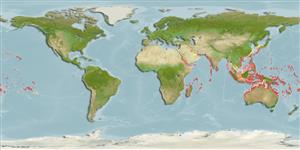Common names from other countries
Environment: milieu / climate zone / depth range / distribution range
экология
ассоциированный с рифами; пределы глубины 0 - 30 m (Ref. 349). Tropical; 37°N - 32°S, 29°E - 127°W
Indo-Pacific: from eastern Africa to Sudan, Egypt, Yemen and India, to southeast Asia and Australia, as far east to Pitcairn Islands and north to Hawaii and Japan. Tropical to subtropical.
Length at first maturity / Size / Вес / Возраст
Maturity: Lm ? range ? - ? cm Max length : 43.0 cm SHL самец/пол неопределен; (Ref. 349); common length : 28.0 cm SHL самец/пол неопределен; (Ref. 349)
Actively collected by native populations for food, by hand at low tide on the reefs, or by diving. In spite of its weight and considerable size, the shell is favored, especially by tourists, due to the beauty of its heavily glazed aperture (Ref. 349). Found on sand near rocks and corals (Ref. 130068).
Life cycle and mating behavior
половая зрелость | размножение | нерест | икра | Fecundity | личинки
Members of the order Neotaenioglossa are mostly gonochoric and broadcast spawners. Life cycle: Embryos develop into planktonic trocophore larvae and later into juvenile veligers before becoming fully grown adults.
Основная ссылка
ссылки | координатор | соавторы
Poutiers, J.M. 1998. (Ref. 349)
Статус Красного Списка МСОП (Ref. 130435)
Статус СИТЕС (Ref. 108899)
Not Evaluated
Not Evaluated
Угроза для людей
Harmless
Использование человеком
рыболовство: коммерческий
| FishSource | Sea Around Us
инструменты
дополнительная информация
Возраст/Размеры
рост
Зависимость между длиной и массой тела
Зависимость между длинами
морфология
личинки
численность
ресурсы в Интернет
Estimates based on models
Preferred temperature
(Ref.
115969): 24.8 - 29.3, mean 28.4 (based on 3207 cells).
Уязвимость
Low to moderate vulnerability (33 of 100).
Категория цены
Unknown.
